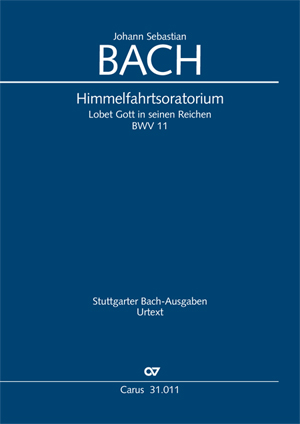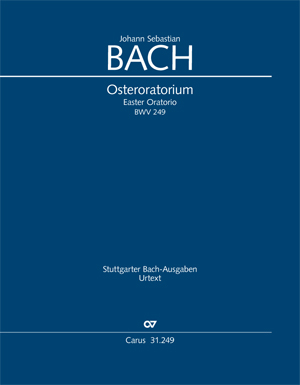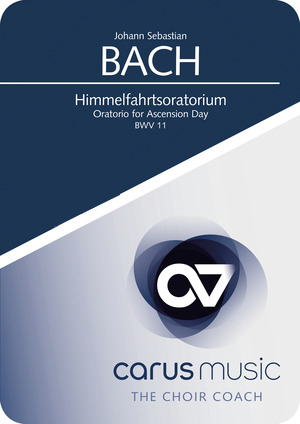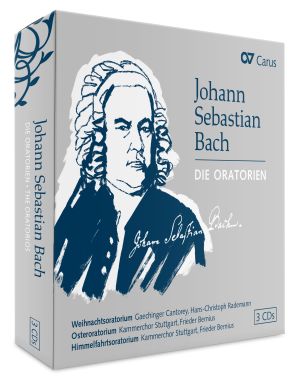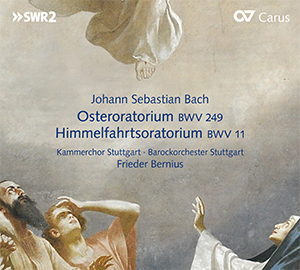
Easter Oratorio BWV 249 & Oratorio for Ascension Day BWV 11
Johann Sebastian Bach himself thought very highly of his Easter Oratorio BWV 249 of 1725. Even though it never attained the popularity of the Christmas Oratorio, Bach himself performed it four times during his lifetime. Some parts of the oratorio originated as parody movements from the birthday cantata "Entfliehet, verschwindet, entweichet, ihr Sorgen" for Christian, Duke of Saxe-Weißenfels. The second work on this CD, the Ascension oratorio "Lobet Gott in seinen Reichen" BWV 11 (1735) also goes back to another work, namely "Froher Tag, verlangte Stunde," a no longer extant cantata composed for the inauguration of the new St. Thomas’s School. In his recording, Frieder Bernius demonstrates at the highest level, that both these oratorios are masterpieces which do not need to hide behind their better known sibling works.
Contents
-
Composer
Johann Sebastian Bach
| 1685-1750Johann Sebastian Bach is one of the most important composers of Western music history. He came from a widely ramified musical dynasty, which produced numerous musicians and organists in the Thuringian-Saxon area.
Bach vocal
Ever since Carus-Verlag was founded in 1972, publishing the music of Johann Sebastian Bach has been a special focus for us. In the 2017 Reformation anniversary year we completed the Bach vocal project. Bach's complete sacred vocal works are now available in modern Urtext editions, together with performance material. A complete edition of all the full scores is also available in a high quality box set. Personal details
-
Preface writer
Ulrich Leisinger
-
Choir
Kammerchor Stuttgart
The Kammerchor Stuttgart is regarded as one of the best ensembles of its kind. Over its fifty-year existence, Frieder Bernius has developed the choir into an exceptional ensemble acclaimed by audiences and press alike. This has led to invitations for the choir to perform at all the important European festivals. In Germany the chamber choir performs at festivals and in concert halls in repertoire ranging from the 17th to the 21st century. Frieder Bernius and his ensemble have received numerous accolades for their contribution to new music. The Kammerchor Stuttgart has made over 80 CDs and LPs, numerous of which have been awarded international recording prizes (including the Edison award, Diapason d’or, Gramophone Choice, Classical Internet Award, International Classical Music Award, and German Record Critics’ Award prizes). The International Federation for Choral Music has invited the ensemble to sing at the 1st, 4th and 10th World Symposia on Choral Music in Vienna, Sydney and Seoul. Regular tours of North America and Asia since 1988 and a South America tour reflect the Kammerchor Stuttgart’s international reputation. Since 1984 the top ensemble has also been invited to Israel biennially. Personal details
-
Orchestra
Barockorchester Stuttgart
The Barockorchester Stuttgart, which was founded by Bernius in 1985, specializes in 18th century music. The musicians are among the leading representatives of historical performance practice and perform exclusively on original instruments. The ensemble dedicates itself to a large extent to the revival of 18th century operas. It has performed at numerous international festivals, among others in Rome, Dresden and Göttingen. Personal details
-
Conductor
Frieder Bernius
| 1947Frieder Bernius’s work has earned great worldwide recognition. He is in demand internationally as a conductor and as a teacher. His principal artistic collaborators are the ensembles he founded himself, the Kammerchor Stuttgart, the Barockorchester Stuttgart, the Hofkapelle Stuttgart and the Klassische Philharmonie Stuttgart. As a guest conductor, he has collaborated repeatedly with, for example, the SWR Vokalensemble Stuttgart, the Deutsche Kammerphilharmonie Bremen, the Stuttgarter Kammerorchester and the Streicherakademie Bozen. Great stylistic versatility is Frieder Bernius’s hallmark. Whether he conducts vocal works by Monteverdi, Bach, Händel, Mozart, Beethoven, Fauré and Ligeti, stage music by Mendelssohn or symphonies by Haydn, Burgmüller and Schubert, his work always aims for a sound that is at once unmistakably personal and at the same time oriented towards the original period sound ideal. He devotes himself equally to the rediscovery of 18th century operas and to first performances of contemporary compositions. He is particularly interested in the musical history of southwestern Germany. Carus-Verlag has awarded Frieder Bernius a Golden CD for his complete recording of the sacred music of Felix Mendelssohn Bartholdy. The award was presented to him during the German Choir Festival in Stuttgart 2016. The sale of over 250,000 recordings, which has been acclaimed with a number of awards, has made a not insignificant contribution to what today is the obvious presence of Mendelssohn's complete œuvre in the concert repertoire. Personal details
-
Soloist - soprano
Joanne Lunn
Joanne Lunn, soprano, studied at the Royal College of Music in London, where she won the renowned Tagore Gold Medal. She regularly concertizes as a soloist with all the renowned early music ensembles. She gave her opera debut at the English National Opera in Monteverdi’s L’incoronazione di Poppea and sang the role of Helena in Britten’s A Midsummer Night’s Dream in Venice, as well as singing in Monteverdi’s L’Orfeo in Paris and Beijing. In the field of oratorio, Joanne Lunn has worked together with conductors such as Bernius, Minkowski, Norrington and Suzuki. Personal details
-
Soloist - alto
Elisabeth Jansson
The Swedish mezzo-soprano Elisabeth Jansson, born 1976, studied at the Richard Strauss Konservatorium in Munich, the Royal Academy of Music in London and the Royal Opera Academy, Copenhagen. She was engaged for principal roles in various opera productions – from 2007 to 2009 she held a soloist ensemble position at The Royal Opera, Copenhagen. Elisabeth Jansson is a much sought after concert singer and has appeared in concerts and at renowned festivals throughout Europe. (BWV 249) Personal details
-
Soloist - alto
David Allsopp
-
Soloist - tenor
Jan Kobow
-
Soloist - tenor
Samuel Boden
The tenor Samuel Boden studied at Trinity College of Music in London with John Wakefield and graduated with distinction in 2006. His repertoire is very broad and includes operas and oratorios ranging from the Baroque to the modern period. His concert repertoire includes, among others, works by Bach, Mozart, Britten and Charpentier. CD recordings of Monteverdi's "Vespers 1610" with the Orchestra of the Age of Enlightenment, cantatas by Pachelbel und Bach, as well as Bach's "B Minor Mass" document his predilection for Baroque music. Personal details
-
Soloist - bass
Gotthold Schwarz
Gotthold Schwarz received his first musical training at the Dresden Kirchenmusikschule and at the Hochschule für Musik Felix Mendelssohn Bartholdy in Leipzig. This bass studied singing with Gerda Schriever and conducting with Max Pommer and Hans-Joachim Rotzsch. He appears regularly throughout Europe with such celebrated artists as Frieder Bernius, Peter Schreier and Philippe Herreweghe. In additoin to his extensive concert activity, some of it in the USA, he has given courses in the interpretation of Bach’s works. Numerous CD and radio productions document his wide repertoire, which along with concert and opera singing includes song recitals featuring literature ranging from the baroque era to the present day. Personal details
-
Soloist - bass
Tobias Berndt
Tobias Berndt began his musical education in the Dresden Kreuzchor. He studied with Christian Polster in Leipzig and continued his training with Rudolf Piernay in Mannheim. He also studied with Dietrich Fischer-Dieskau and Thomas Quasthoff. He was a laureate in numerous renowned singing competitions, winning – among others – the International Das Lied Competition in Berlin, the International Brahms Competition and the Cantilena Singing Competition. Tobias Berndt has also established himself abroad as an opera and concert singer. He has collaborated with conductors such as Philippe Herreweghe, Helmuth Rilling, Frieder Bernius, Teodor Currentzis, Marcus Creed, Hans-Christoph Rademann, Andrea Marcon, Marek Janowski and Sir Roger Norrington and has performed at the Berliner Philharmonie, the Tonhalle in Zurich, the Concertgebouw Amsterdam, the Leipzig Gewandhaus, the Tchaikovsky Concert Hall in Moscow, the Teatro Colon in Buenos Aires and at Lincoln Center in New York. He has also performed at important festivals such as the Prague Spring, the Rheingau Musik Festival, the Händel Festivals in Göttingen und Halle, the Bachfest Leipzig, the Oregon Bach Festival and the International Music Festival in Peking. An extensive discography attests to his versatile artistic activities. Personal details
Reviews
Leichtfüßiger Schwung und warme Timbres beleben mit ausdrucksvoller Gestaltungsfreude das Oster- und das Himmelfahrtsoratorium ... Eine erstklassige Einspielung mit dem Barockorchester Stuttgart unter Frieder Bernius.
Anne Zehrt, www. klassik.com, 18.11.2016
Frieder Bernius formt aus dem reichhaltigen Mikrokosmos dieser beiden Oratorien [...] eine spontan zugängliche, interpretatorisch überzeugende und rhetorisch spannende Klangrede.
Musik & Liturgie, März 2016
Xenia Löffler musiziert ein bewundernswert >>geschwindes<< Oboe d'amore-Solo... - wie überhaupt das historische Instrumentarium mit souveränder Leichtigkeit, Ausdrucksfülle und Phrasierungskunst gespielt wird.
Ann-Katrin Zimmermann, Jahrbuch 2015 "Musik in Baden-Württemberg"
In his recording, Frieder Bernius conducts the Barockorchester Stuttgart and Kammerchor Stuttgart in fine performances of both these masterpieces.
http://www.new-classics.co.uk
”[…] eine insgesamt gelungene, empfehlenswerte Neuerscheinung auf dem Tonträgermarkt.”
Rashid-S. Pegah, Musik & Kirche, Juli/August 2015
...les récitatifs sont très théâtraux et on y entend un ténor au timbre moelleux, Samuel Boden. Le chœur d’entrée séduit par sa verve.
Jean-Luc Macia, Diapason, Juli 2017
„Festmusik ist [...] der Leitfaden von Frieder Bernius’ Lektüre – es geht immerhin um Auferstehung und Himmelfahrt. Frieder Bernius vermeidet aber unmotiviertes, plakatives Jubelgeschrei. Er lässt die Chöre triumphieren, wenn sie von Lachen und Scherzen singen, lässt die Solisten aber ebenso staunen und bedrückt sein, wenn es um die Entdeckung des leeren Grabes geht und eine gewisse Unruhe und Unsicherheit sich breit machen.”
Guy Engels, pizzicato.lu, 10. April 2015
Frequent questions about this work
 There are no questions and answers available so far or you were unable to find an answer to your specific question about this work? Then click here and send your specific questions to our Customer Services!
There are no questions and answers available so far or you were unable to find an answer to your specific question about this work? Then click here and send your specific questions to our Customer Services!






